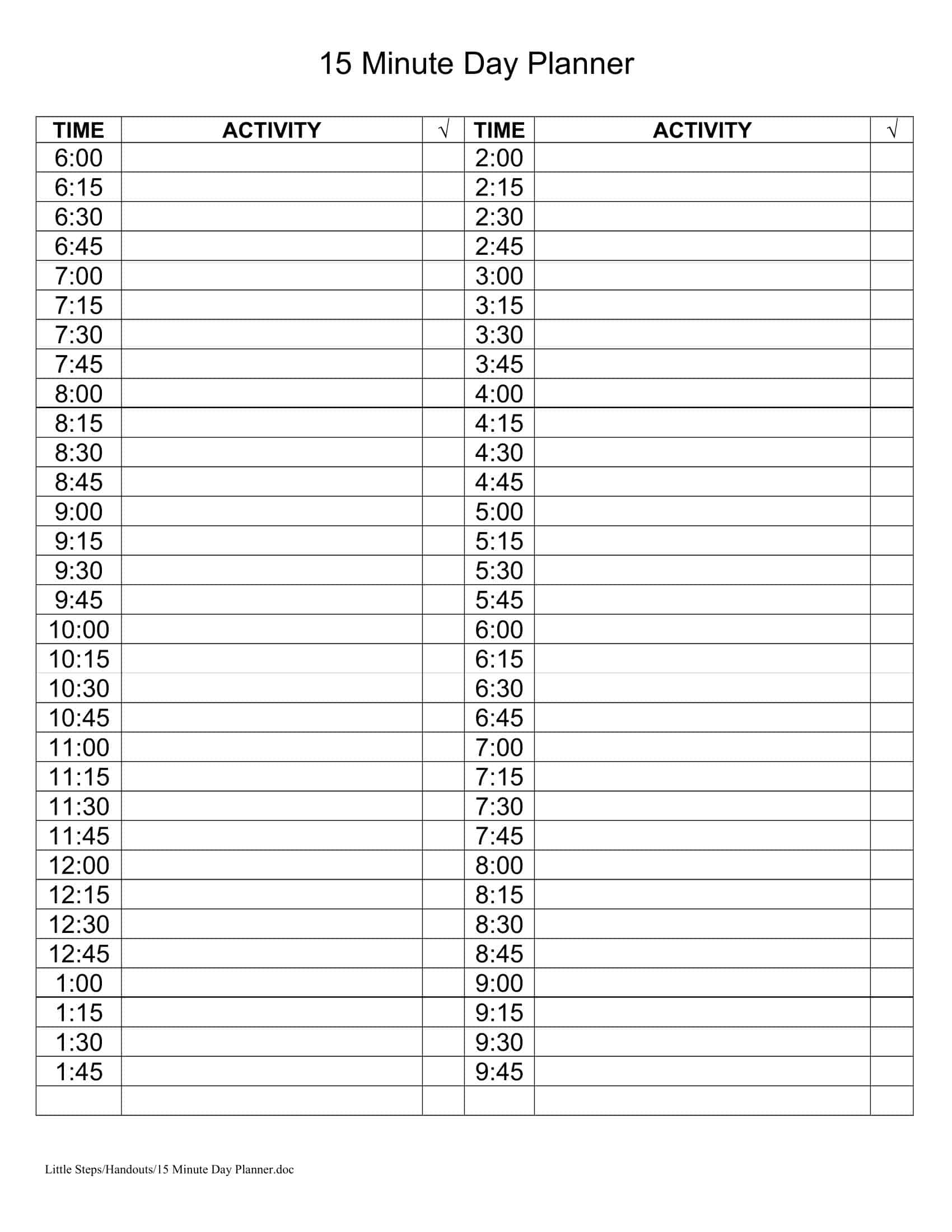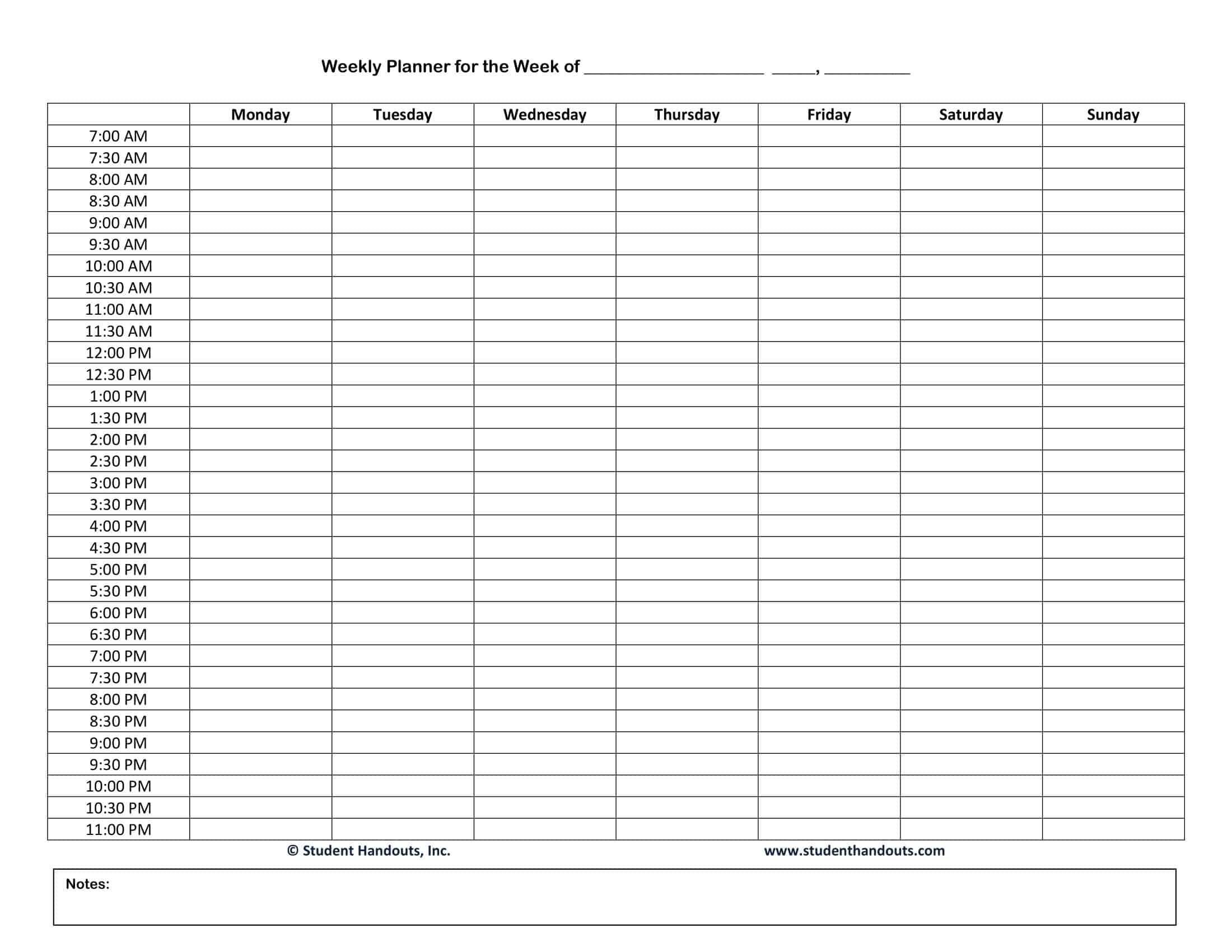A daily planner is a useful tool for organizing your time and keeping track of your daily tasks and activities. It can help you prioritize your responsibilities, reduce stress, and increase productivity. Whether you prefer a physical planner or an electronic one, having a daily planner can make a big difference in your overall sense of organization and control. In this article, we’ll discuss the benefits of using a daily planner and provide tips for making the most of this valuable tool.
Table of Contents
Daily Planner Templates
Daily Planner Templates are essential tools that help individuals organize and manage their daily tasks, appointments, and goals in a structured and efficient manner. These templates provide a framework for planning out the day, allowing users to prioritize their activities and maximize productivity.
A Daily Planner Template typically includes sections to input the date, time slots for scheduling appointments or events, a to-do list for tasks and activities, and additional space for notes and reminders. The layout is designed to be clear and user-friendly, enabling individuals to easily navigate and comprehend their daily schedule at a glance.
The primary benefit of using Daily Planner Templates is the ability to maintain a sense of control and structure in one’s daily life. By utilizing these templates, individuals can carefully plan their activities, allocate time for important tasks, and avoid feeling overwhelmed or scattered. This level of organization helps individuals stay focused, manage their time effectively, and achieve their desired goals.
Benefits of Using a Daily Planner

Using a daily planner offers numerous benefits that can help you lead a more organized and productive life. Here are some of the key benefits of using a daily planner:
Increased Productivity: By writing down your tasks and scheduling your time, you can focus on what needs to be done and avoid distractions and procrastination.
Better Time Management: A daily planner helps you prioritize your tasks and allocate your time more efficiently. This can help you avoid overbooking yourself and ensure that you have time for the things that matter most.
Reduced Stress: With a clear and organized schedule, you can reduce stress and feel more in control of your life. This can help you feel more relaxed and focused on what’s important.
Improved Goal Setting: A daily planner allows you to set and track your short-term and long-term goals. This can help you stay motivated and focused on what you want to achieve.
Better Memory: By writing down important information and events, you can improve your memory and ensure that you don’t forget anything important.
Increased Accountability: When you write down your tasks and goals, you hold yourself accountable for completing them. This can help you stay focused and motivated to achieve your objectives.
Better Work-Life Balance: A daily planner can help you balance your work and personal life by ensuring that you allocate enough time for both. This can help you avoid burnout and lead a more fulfilling life.
Improved Communication: A daily planner can help you coordinate with others by keeping track of appointments, meetings, and other important events. This can improve communication and avoid conflicts.
Enhanced Creativity: A daily planner can help you allocate time for creative pursuits and hobbies. This can provide a much-needed break from your routine and help you tap into your creative side.
Better Budgeting: You can also use your daily planner to track your spending and manage your finances. This can help you stay within budget and avoid overspending.
Types of Daily Planner Template
There are several types of daily planner templates available, each with its own unique features and benefits. Some of the most common types include:
Hourly Planner: This type of planner breaks down each day into hour-long increments, allowing you to schedule appointments and tasks with precision.
To-Do List Planner: This type of planner focuses on lists of tasks that need to be completed, rather than scheduling appointments. It’s ideal for those who prefer to work through a list of tasks rather than scheduling blocks of time.
Gratitude Planner: This type of planner includes prompts for reflection and gratitude, encouraging you to focus on the positive aspects of your life.
Bullet Journal Planner: This type of planner combines elements of a traditional daily planner with a journal, allowing you to track both your tasks and your thoughts and feelings.
Meal Planner: This type of planner is specifically designed for meal planning and grocery shopping, allowing you to plan and track your meals for the week.
Fitness Planner: This type of planner is designed for tracking fitness and health goals, including workout routines and meal plans.
Academic Planner: This type of planner is specifically designed for students, with features such as class schedules, assignment tracking, and exam reminders.
Project Planner: This type of planner is designed for managing complex projects and breaking them down into manageable tasks. It can help you track progress, deadlines, and team member responsibilities.
Travel Planner: This type of planner is designed for people who travel frequently, allowing you to keep track of flights, hotel reservations, and other travel details.
Habit Tracker: This type of planner is designed for tracking habits and behaviors, allowing you to monitor your progress and stay accountable.
Digital Planner: This type of planner is designed for use on a computer or mobile device, with features such as drag-and-drop scheduling, automatic reminders, and cloud synchronization.
Personal Planner: This type of planner is designed for personal use and can include a wide range of features, from goal setting and habit tracking to scheduling and note-taking.
Custom Planner: This type of planner allows you to create your own custom template, choosing the features and layout that best meet your needs.
The type of daily planner template you choose will depend on your specific needs and preferences. Some people may prefer a more structured, hour-by-hour planner, while others may prefer a more flexible, task-based planner. Regardless of which type you choose, the key is to find a template that works for you and helps you stay organized and productive.
How do you organize your daily planner?
Organizing your daily planner can help you stay on top of your tasks and commitments, leading to a more productive and stress-free life. Here are some tips for organizing your daily planner:
Prioritize Your Tasks: Write down your most important tasks for the day, week, and month, and prioritize them based on their level of urgency and importance.
Schedule Blocks of Time: Allocate blocks of time for each task, taking into account the amount of time it will take to complete and any other appointments or commitments you have.
Use Color Coding: Use different colors to categorize your tasks, such as work, personal, or urgent tasks. This can help you quickly identify what needs to be done and prioritize your time accordingly.
Keep Notes: Write down any notes or additional information related to each task, such as reminders or action steps. This can help you stay on top of details and avoid forgetting anything important.
Review and Reflect: At the end of each day, review your planner to see what you accomplished and what still needs to be done. Reflect on what worked well and what could be improved, and make any necessary adjustments.
Be Flexible: Don’t be afraid to make changes to your schedule as needed. Life is unpredictable, and sometimes things come up that require you to adjust your schedule. A good daily planner should be flexible and allow for changes.
Make It a Habit: Make using your daily planner a habit by using it every day, without fail. This can help you stay on track and ensure that you never miss an important task or appointment.
What should I write in my daily planner?
A daily planner can be a powerful tool for staying organized and on top of your tasks and commitments. Here are some things you may consider writing in your daily planner:
Appointments and Meetings: Write down any appointments or meetings you have scheduled, including the time, location, and purpose.
Tasks and To-Do Lists: Write down the tasks you need to complete for the day, prioritizing based on urgency and importance. Consider breaking down larger tasks into smaller, more manageable steps.
Goals: Write down your short-term and long-term goals, and use your daily planner to track your progress and stay accountable.
Meal and Snack Planning: Write down what you plan to eat for each meal and snack, to help you stay on track with your nutrition goals.
Exercise and Physical Activity: Write down any planned exercise or physical activity, including the type and duration of the activity.
Gratitude and Reflection: Write down things you are grateful for, as well as any insights or reflections you have during the day.
Notes and Reminders: Write down any notes or reminders related to appointments, tasks, or anything else you need to remember.
By writing these things in your daily planner, you can stay organized and on top of your schedule, tasks, and goals. Remember to review and reflect on your planner regularly to see what you’ve accomplished and what still needs to be done.
FAQs
What should I look for when choosing a daily planner?
When choosing a daily planner, consider your specific needs and preferences, such as the size and format, features and layout, and level of customization. You may also consider whether you prefer a paper or digital planner.
What is the difference between a daily planner and a planner for the week or month?
A daily planner focuses on organizing and keeping track of your schedule and tasks for a single day, while a planner for the week or month provides a broader view of your schedule and commitments over a longer time period.
How do I keep my daily planner up-to-date?
You can keep your daily planner up-to-date by regularly reviewing and updating it, adding new appointments and tasks as they arise, and crossing off completed items.
Can a daily planner help with productivity?
Yes, a daily planner can help with productivity by giving you a clear understanding of your schedule and tasks, allowing you to prioritize and manage your time more effectively.
Can a daily planner be used for personal and work-related tasks?
Yes, a daily planner can be used for both personal and work-related tasks, allowing you to keep track of all your commitments and responsibilities in one place.
How do I make my daily planner more fun and enjoyable to use?
You can make your daily planner more fun and enjoyable to use by adding colorful stickers, washi tape, and other decorations, writing in a journaling style, using motivational quotes and affirmations, and making it a habit.
Is a daily planner better than using a smartphone or computer for organizing my schedule?
Whether a daily planner or a digital tool is better depends on your personal preferences and needs. Some people prefer the tangible and tactile experience of a paper planner, while others prefer the convenience and accessibility of a digital tool.



















































![Free Printable Roommate Agreement Templates [Word, PDF] 1 Roommate Agreement](https://www.typecalendar.com/wp-content/uploads/2023/06/Roommate-Agreement-150x150.jpg)
![Free Printable Credit Card Authorization Form Templates [PDF, Word, Excel] 2 Credit Card Authorization Form](https://www.typecalendar.com/wp-content/uploads/2023/06/Credit-Card-Authorization-Form-150x150.jpg)
![Free Printable Stock Ledger Templates [Excel,PDF, Word] 3 Stock Ledger](https://www.typecalendar.com/wp-content/uploads/2023/08/Stock-Ledger-150x150.jpg)
